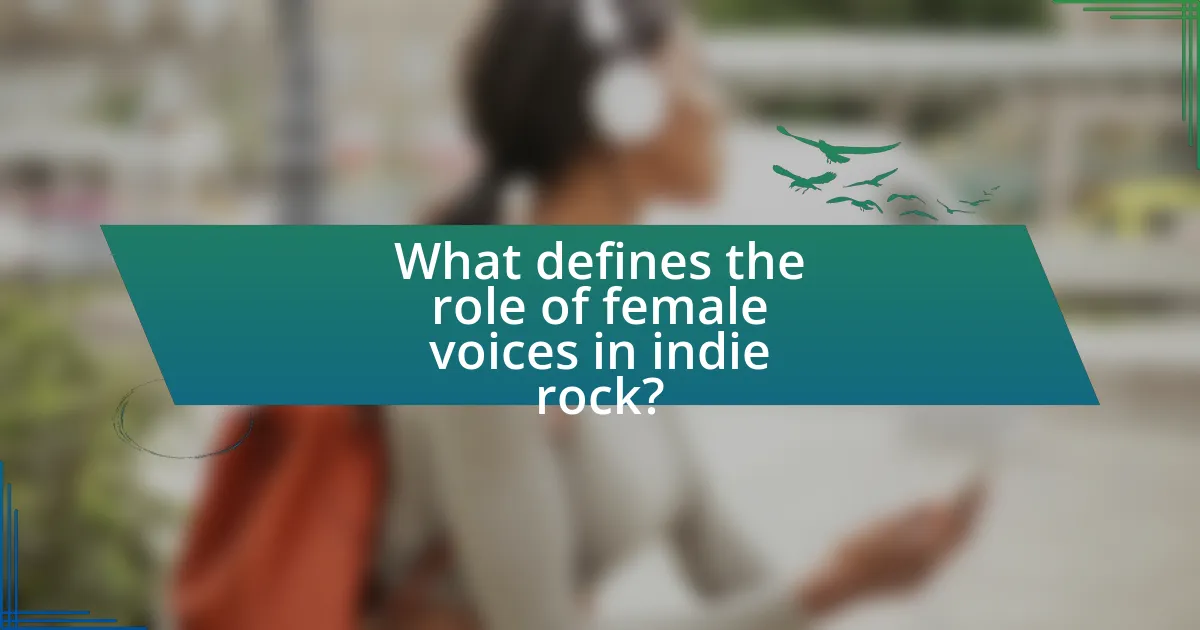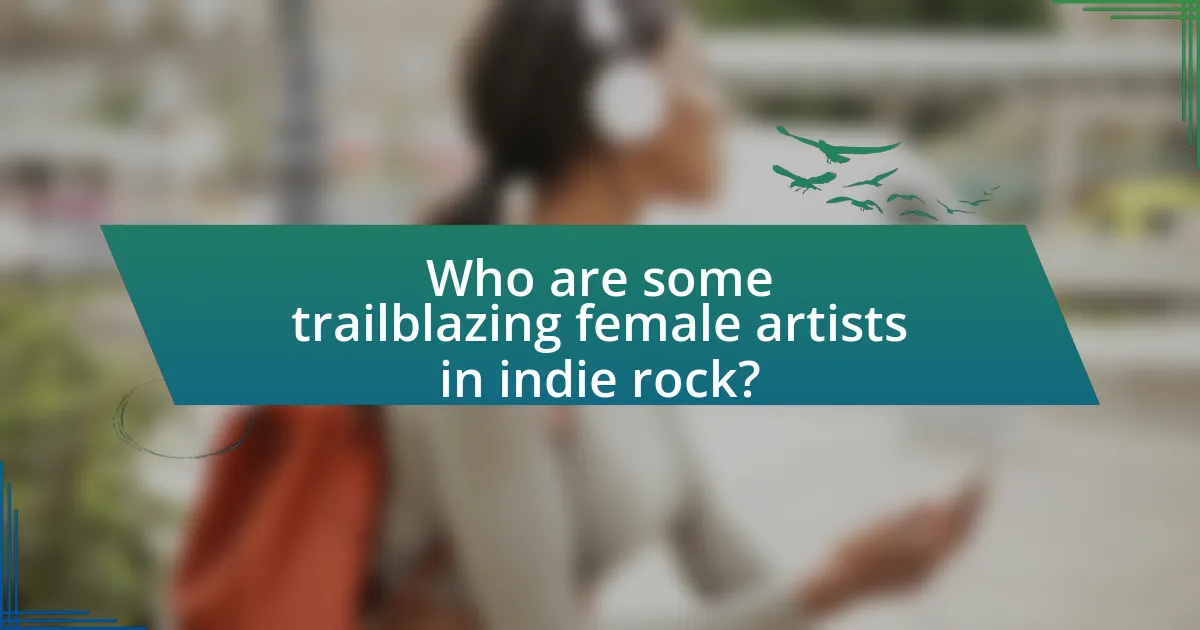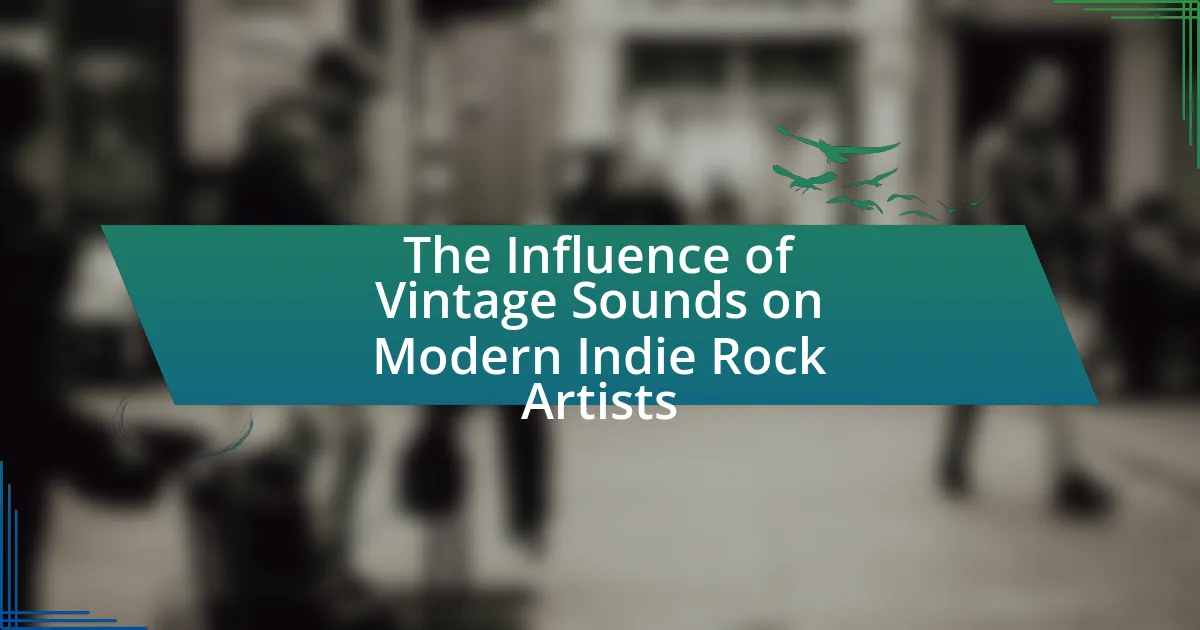The article focuses on the significant role of female voices in indie rock, highlighting how these artists challenge traditional gender norms and contribute diverse perspectives to the genre. It examines the influence of trailblazing musicians such as Björk, St. Vincent, PJ Harvey, and Liz Phair, who have reshaped lyrical content and expanded the emotional range of indie rock. The article also discusses the unique characteristics of female-led bands, the challenges they face in a male-dominated industry, and the importance of celebrating their contributions to promote diversity and representation in music. Additionally, it outlines initiatives and resources aimed at supporting female artists and enhancing their visibility within the indie rock community.

What defines the role of female voices in indie rock?
The role of female voices in indie rock is defined by their ability to challenge traditional gender norms and bring diverse perspectives to the genre. Female artists in indie rock often explore themes of identity, empowerment, and emotional vulnerability, which resonate with a wide audience. For instance, artists like Björk and St. Vincent have pushed creative boundaries, influencing the sound and direction of indie rock while addressing social issues through their lyrics. Their contributions have not only enriched the musical landscape but have also paved the way for future generations of female musicians, as evidenced by the increasing visibility and success of women in the genre over the past two decades.
How have female artists influenced the indie rock genre?
Female artists have significantly influenced the indie rock genre by introducing diverse perspectives, innovative sounds, and challenging societal norms. Artists like PJ Harvey and Liz Phair have reshaped lyrical content, focusing on themes of empowerment and personal experience, which has broadened the emotional range of indie rock. Additionally, the rise of bands such as Sleater-Kinney and Bat for Lashes has showcased the importance of female collaboration and leadership in a predominantly male-dominated space. Their contributions have not only enriched the genre’s musical landscape but have also inspired a new generation of female musicians to pursue careers in indie rock, leading to increased visibility and representation within the industry.
What are some key characteristics of female-led indie rock bands?
Female-led indie rock bands often exhibit a distinct blend of authenticity, emotional depth, and innovative sound. These bands frequently prioritize personal and introspective lyrics, reflecting the unique experiences and perspectives of women. For instance, artists like Sleater-Kinney and Florence + The Machine have been noted for their powerful storytelling and exploration of themes such as identity, empowerment, and social issues. Additionally, female-led bands often challenge traditional gender roles within the music industry, promoting a more inclusive and diverse representation in rock music. This shift has been supported by increased visibility and recognition of female artists in festivals and award shows, highlighting their significant contributions to the genre.
How do female artists challenge traditional rock narratives?
Female artists challenge traditional rock narratives by redefining themes, aesthetics, and roles within the genre. They often address issues such as gender inequality, personal identity, and social justice, which contrasts with the historically male-dominated narratives. For example, artists like PJ Harvey and Courtney Love have used their music to critique societal norms and express female empowerment, thereby reshaping the expectations of rock music. Additionally, the rise of indie rock acts like Mitski and Phoebe Bridgers showcases a shift towards more introspective and vulnerable songwriting, further challenging the aggressive and often superficial tropes associated with traditional rock. This evolution in content and perspective highlights the significant impact female artists have on the genre, promoting diversity and inclusivity in rock music.
Why is it important to celebrate female voices in indie rock?
Celebrating female voices in indie rock is important because it promotes diversity and representation within a genre historically dominated by male artists. Female musicians bring unique perspectives and experiences that enrich the music landscape, fostering innovation and creativity. For instance, studies show that diverse teams produce more innovative outcomes; similarly, the inclusion of female artists in indie rock leads to a broader range of themes and sounds. Furthermore, recognizing and supporting female voices helps to challenge gender stereotypes and encourages young women to pursue careers in music, contributing to a more equitable industry.
What impact do female artists have on representation in music?
Female artists significantly enhance representation in music by challenging gender norms and diversifying the industry. Their presence in various genres, particularly in indie rock, has led to increased visibility for women’s perspectives and experiences. For instance, the rise of artists like Phoebe Bridgers and Mitski has not only garnered critical acclaim but also inspired a new generation of female musicians to express their unique narratives. Research indicates that female-led bands and solo acts contribute to a more inclusive music scene, as evidenced by the 2020 report from the Annenberg Inclusion Initiative, which found that women comprised only 21.6% of artists in popular music, highlighting the ongoing need for greater representation. This underrepresentation underscores the vital role female artists play in shaping a more equitable music landscape.
How does the presence of female voices shape the indie rock community?
The presence of female voices significantly shapes the indie rock community by diversifying its sound and expanding its cultural narratives. Female artists bring unique perspectives and experiences that challenge traditional gender roles within the genre, fostering a more inclusive environment. For instance, the rise of artists like Phoebe Bridgers and Mitski has not only garnered critical acclaim but also inspired a new generation of musicians to explore themes of identity, mental health, and empowerment. This shift is evidenced by the increasing number of female-led bands and solo acts in indie rock festivals, which have seen a 50% increase in female performers over the past decade, according to a 2021 report by the Annenberg Inclusion Initiative. Such statistics highlight the growing influence of female voices in shaping the community’s identity and sound.

Who are some trailblazing female artists in indie rock?
Some trailblazing female artists in indie rock include Liz Phair, who gained prominence in the 1990s with her influential album “Exile in Guyville,” and Sleater-Kinney, a band known for their feminist themes and powerful sound. Additionally, St. Vincent, led by Annie Clark, has been recognized for her innovative approach and critically acclaimed albums. These artists have significantly shaped the indie rock landscape, paving the way for future generations of female musicians.
What contributions have iconic female indie rock artists made?
Iconic female indie rock artists have significantly shaped the genre by introducing diverse perspectives, challenging gender norms, and influencing musical styles. Artists like PJ Harvey and Liz Phair have pushed boundaries with their lyrical content, addressing themes of feminism, sexuality, and personal identity, which have resonated with audiences and inspired subsequent generations of musicians. Additionally, the rise of bands such as Sleater-Kinney and Bat for Lashes has showcased the importance of female collaboration and representation in a predominantly male industry, leading to a broader acceptance of women in rock music. Their contributions have not only enriched the indie rock landscape but have also paved the way for greater visibility and opportunities for female artists in the music industry.
How did artists like PJ Harvey and Liz Phair pave the way for future generations?
Artists like PJ Harvey and Liz Phair paved the way for future generations by challenging gender norms and redefining female representation in rock music. PJ Harvey’s raw, emotive songwriting and innovative sound, particularly in albums like “Rid of Me,” showcased a powerful female perspective that influenced countless artists. Similarly, Liz Phair’s debut album “Exile in Guyville” presented candid narratives about female sexuality and identity, earning critical acclaim and commercial success. Their work not only inspired a new wave of female musicians to express their voices authentically but also contributed to the broader acceptance of women in genres traditionally dominated by men, thus shaping the landscape of indie rock for future generations.
What unique styles and messages do contemporary female indie rock artists bring?
Contemporary female indie rock artists bring diverse styles and messages that often challenge societal norms and explore personal narratives. These artists frequently incorporate elements of folk, punk, and electronic music, creating a unique sound that reflects their individual experiences and perspectives. For instance, artists like Phoebe Bridgers and Mitski utilize introspective lyrics to address themes of mental health, identity, and relationships, resonating with a broad audience. Additionally, the incorporation of feminist themes and social commentary in their music serves to empower listeners and provoke thought, as seen in the works of artists like Snail Mail and Soccer Mommy. This blend of musical innovation and poignant messaging underscores the significant impact of contemporary female indie rock artists in shaping the genre.
Which emerging female artists are shaping the future of indie rock?
Emerging female artists shaping the future of indie rock include artists like Phoebe Bridgers, Snail Mail, and Arlo Parks. Phoebe Bridgers has gained significant recognition for her introspective songwriting and unique sound, exemplified by her critically acclaimed album “Punisher,” which was nominated for multiple Grammy Awards in 2021. Snail Mail, led by Lindsey Jordan, has made waves with her debut album “Lush,” showcasing a fresh perspective on indie rock and earning praise for its emotional depth. Arlo Parks, with her debut album “Collapsed In Sunbeams,” has been celebrated for her poetic lyrics and genre-blending style, winning the Brit Award for Best New Artist in 2021. These artists are not only redefining the genre but also influencing a new generation of musicians.
What themes do new female voices in indie rock explore?
New female voices in indie rock explore themes of identity, empowerment, mental health, and social issues. These artists often address personal experiences and societal challenges, reflecting a diverse range of perspectives. For instance, many songs delve into the complexities of gender and sexuality, highlighting the struggles and triumphs of being a woman in a male-dominated industry. Additionally, mental health is a recurring theme, with artists like Phoebe Bridgers and Mitski openly discussing anxiety and depression in their lyrics. This focus on authenticity and vulnerability resonates with listeners, creating a strong emotional connection. Furthermore, social issues such as feminism, race, and environmental concerns are increasingly prevalent in their music, showcasing a commitment to activism and change.
How are these artists redefining the genre today?
These artists are redefining the indie rock genre today by infusing diverse musical influences and addressing contemporary social issues through their lyrics. For instance, artists like Phoebe Bridgers and Mitski incorporate elements of folk, pop, and electronic music, creating a sound that transcends traditional indie rock boundaries. Additionally, they tackle themes such as mental health, identity, and feminism, resonating with a broader audience and challenging the genre’s historical norms. This shift is evidenced by the increasing presence of female-led bands and solo acts in mainstream music charts, highlighting a significant change in the industry’s landscape.

What challenges do female artists face in the indie rock scene?
Female artists in the indie rock scene face significant challenges, including gender bias, limited access to industry resources, and underrepresentation in media coverage. Gender bias manifests in the form of stereotypes that question their musical abilities and leadership roles, often leading to fewer opportunities for performances and collaborations. Limited access to industry resources, such as funding and networking opportunities, further hinders their ability to promote their work effectively. Additionally, studies indicate that female artists receive less media attention compared to their male counterparts, which impacts their visibility and marketability. For instance, a report by the Annenberg Inclusion Initiative found that only 22.5% of artists in popular music were women, highlighting the systemic barriers female artists encounter in gaining recognition and support within the indie rock genre.
How do societal perceptions affect female musicians in indie rock?
Societal perceptions significantly affect female musicians in indie rock by shaping their opportunities, visibility, and the reception of their work. Female artists often face stereotypes that question their musical abilities and authenticity, leading to challenges in gaining recognition compared to their male counterparts. For instance, a study by the Annenberg Inclusion Initiative found that only 22% of artists in popular music were women, indicating a systemic bias in the industry that limits female representation. Additionally, female musicians frequently encounter scrutiny regarding their appearance and behavior, which can detract from their artistic contributions. This societal bias not only influences the way audiences perceive female musicians but also affects their access to resources, such as funding and media coverage, ultimately impacting their careers in the indie rock scene.
What barriers do female artists encounter in the music industry?
Female artists encounter significant barriers in the music industry, including gender bias, lack of representation, and limited access to funding and resources. Gender bias manifests in the form of stereotypes that question women’s musical abilities and leadership roles, often leading to fewer opportunities for female artists in key positions such as producers and executives. According to a 2021 report by the Annenberg Inclusion Initiative, women comprised only 21.6% of artists in popular music, highlighting the lack of representation. Additionally, female artists often face challenges in securing funding for projects, as studies show that women-led projects receive less investment compared to their male counterparts. These barriers collectively hinder the progress and visibility of female artists in the music industry.
How can the indie rock community support female artists more effectively?
The indie rock community can support female artists more effectively by actively promoting their work through dedicated platforms and events. Initiatives such as female-focused music festivals, showcases, and playlists can increase visibility for female artists, as evidenced by the success of events like the “Girls Rock Camp,” which has empowered numerous female musicians. Additionally, the community can foster mentorship programs that connect established female artists with emerging talent, creating a supportive network that encourages growth and collaboration. Research indicates that female representation in music festivals remains low, with only 20% of performers being women, highlighting the need for targeted efforts to elevate female voices in the indie rock scene.
What initiatives exist to promote female voices in indie rock?
Initiatives that promote female voices in indie rock include organizations like Girls Rock Camp, which provides mentorship and music education to young girls, fostering their creativity and confidence in music. Additionally, festivals such as the She Rocks Awards celebrate female musicians and industry professionals, highlighting their contributions to the genre. Furthermore, platforms like Bandcamp have dedicated sections for female artists, ensuring visibility and support for their work. These initiatives collectively aim to empower women in the indie rock scene, addressing gender disparities and encouraging greater representation.
How do festivals and organizations contribute to female representation?
Festivals and organizations contribute to female representation by actively promoting female artists and creating platforms for their visibility. For instance, events like the all-female music festival Lilith Fair, which ran from 1997 to 1999, showcased numerous female musicians, significantly increasing their exposure in the industry. Additionally, organizations such as She Rocks Awards honor women in music, providing recognition and inspiring future generations of female artists. Research indicates that festivals featuring diverse lineups, including female performers, can lead to increased attendance and engagement, demonstrating the positive impact of representation on audience dynamics.
What role do mentorship programs play in supporting female artists?
Mentorship programs play a crucial role in supporting female artists by providing guidance, networking opportunities, and skill development. These programs connect emerging female artists with established professionals who can offer insights into the industry, helping to navigate challenges specific to women in the arts. For instance, a study by the National Endowment for the Arts found that mentorship significantly increases the likelihood of career advancement for female artists, as they gain access to resources and support systems that are often lacking. Additionally, mentorship fosters a sense of community, empowering women to share experiences and collaborate, which is essential in the male-dominated indie rock scene.
What can listeners do to support female voices in indie rock?
Listeners can support female voices in indie rock by actively seeking out and promoting music created by female artists. This includes streaming their songs on platforms like Spotify and Apple Music, purchasing their albums, and attending their live performances. By doing so, listeners contribute to the visibility and financial success of these artists, which is crucial in an industry where female representation is often underrepresented. According to a 2021 study by the Annenberg Inclusion Initiative, only 22.5% of artists in popular music are women, highlighting the need for increased support. Engaging with female artists on social media and sharing their work can further amplify their reach and influence.
How can fans engage with and promote female indie rock artists?
Fans can engage with and promote female indie rock artists by actively sharing their music on social media platforms, attending live shows, and purchasing merchandise. Social media engagement, such as sharing posts, tagging artists, and using relevant hashtags, increases visibility and helps build a supportive community. Attending concerts not only shows support but also contributes to the artists’ financial success and exposure. Additionally, buying merchandise directly from artists supports their careers and fosters a deeper connection between fans and musicians. According to a 2021 report by the Music Industry Research Association, grassroots support significantly impacts the success of indie artists, highlighting the importance of fan involvement in promoting female talent in the indie rock scene.
What are some recommended playlists or resources to discover female artists?
To discover female artists, recommended playlists include “Women of Indie,” “She’s in the Band,” and “Feminist Punk.” These playlists feature a diverse range of female musicians across various genres, highlighting their contributions to the music industry. Additionally, resources such as Spotify’s “Women Who Rock” and Apple Music’s “Female Artists” collections provide curated selections that celebrate female talent. These playlists and resources are regularly updated, ensuring listeners have access to both emerging and established female artists.




